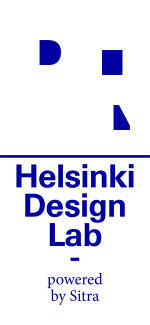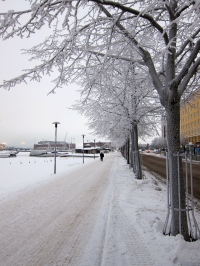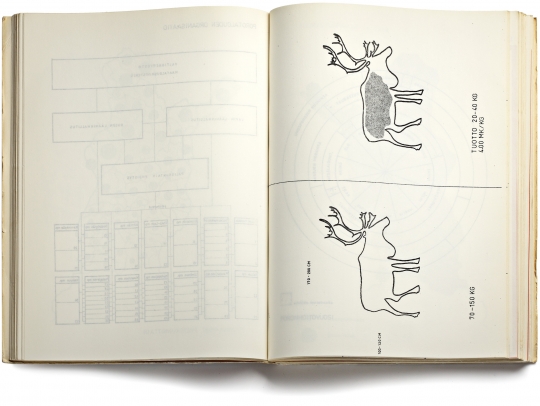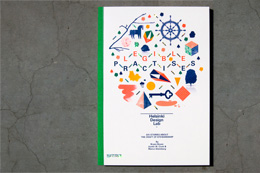Weeknotes
We're entering that ambiguous middle phase of a project where things are sufficiently developed that there's A Lot to Do, but not yet so imminent as to be fiercely urgent. That's a fancy way of saying that there are many things on the burner but only a few tangible outcomes.
Adriel, Ezra, and Justin finished up their respective Challenge Briefing drafts on Friday. Justin and Adriel are each celebrating by taking some well-earned vacation to Peru and Florida, respectively. Send us some sunshine. OK, gentlemen?

This is why we need a sunshine delivery. Photo by Tomi Kukkonen on Flickr.
Next week Marco and I will be reviewing the drafts with the partners for each of the studios and then sending everything off to TwoPoints in Barcelona to turn the Word docs into booklets, which should be done around the end of March.
Seungho spent a day and a half in the belly of the National Archives for Prints and Photographs digging up historical images of Finland's settlements, work life, and family conditions to be used in these booklets. Now he's off to Cambodia with Aalto University's City in Crisis program. We're looking forward to hearing from him while he's away. If he has time, Seungho promised to post some short updates to the blog.
Hanna continues to search for a studio space. Some promising leads but nothing confirmed yet. Jaana and Minna are exploring diplomatic protocol for some of our invites.
Marco happened to choose the week of Snowpocalypse to visit the US for meetings with some potential partners. He reports good conversations in Boston and New York City, but the DC leg unfortunately had to be canceled. This will be rescheduled, though, since we had a packed session planned on Capitol Hill.
I've been doing lots of little things. It feels a bit like building a car while it's already starting to roll out of the garage. Confirming studio participants, working on bits of our collaboration infrastructure, preparing content for the website relaunch, interviewing designers for the HDL 2010 identity, and drinking a lot of tea. The Ambiguous Middle Phase continues.
Judging by the fact that there are only thirty minutes left in week #048 and I'm just now beginning the weeknote, it was a long one.
More of everything. More visits to possible venues around Senaatintori, more people confirmed for the HDL Studios, more work on the Challenge Briefings that belong to those studios, more people on the team. Welcome, Sanna!
With all of this comes a different "more:" waiting. We have inquiries out on a few key bits of our September plans and the wait is near excruciating. Luckily there's plenty of work to distract us while we wait.
Adriel and Ezra spent the weekend working with Justin on the Challenge Briefings. Those are set to be 100% complete drafts in two weeks, so everyone is feeling the pressure to not only cross the tees and dot the eyes, but also make sure the structure and positioning are just right and that the information is accurate and complete. On Wednesday we experienced a first for HDL: Justin, Marco, and I held a three continent conference call to talk through some of the remaning high level questions for the briefings.
My week was split between Helsinki and Bangalore. It started in India with filmmaker Helen Han and designer/entrepreneur Poonam Bir Kasturi. Poonam is the founder of a project called The Daily Dump which offers a grass roots approach to waste management and reduction in the form of composting. Poonam and her team have been recognized by everyone from INDEX to TED, so it's no surprise that her work is inspiring. What we find particularly interesting is her approach to the systemic challenge of waste management. It's a huge, messy problem with no magic bullet. Poonam's response is an enterprise which is designed from the start to be inclusive and diffuse.
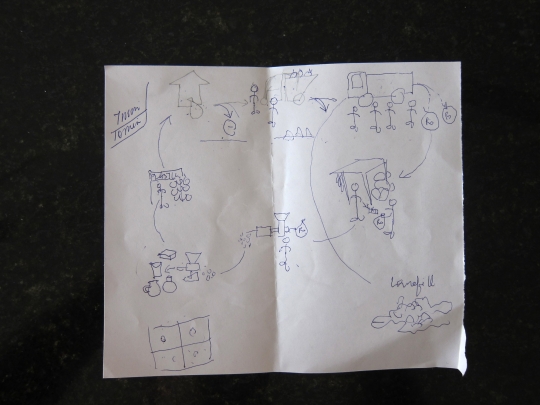
Poonam's sketch of the recycling cycle in Bangalore.
The Daily Dump is a manifold approach involving both products and services, supported by a culture of knowledge that casually informs people about the implications of their lifestyle choices. This is furthered by educational materials and curricula developed for use in elementary schools so that kids can learn about these issues more directly. From a business point of view, one unique property of the Daily Dump is that it's open source. The ideas are published for anyone to copy or adapt in their own area.
With twelve established clones, including one in her own neighborhood of Bangalore, this strategy is beginning to pay dividends as the collective body of knowledge about composting and the tools that enable it grow with each new clone context. The sum total is an ambitious, frenetic project that keeps Poonam and her team very busy. During my short few days in their offices the conversation was constantly switching between languages and subjects. I was a happy fly on the wall as Poonam discussed pricing strategies with some of her clones while simultaneously switching in an out of a design critique of their new website.
Helen will be there for two months as an embedded designer, both helping the Daily Dump articulate the narrative of their work as well as making a short film about the recycling networks within the city of Bangalore. This is a new area of exploration for Poonam and her team and we're thrilled to have an inside look at how the work develops. Helen's film will debut at HDL 2010 and we'll post it here shortly afterwards!
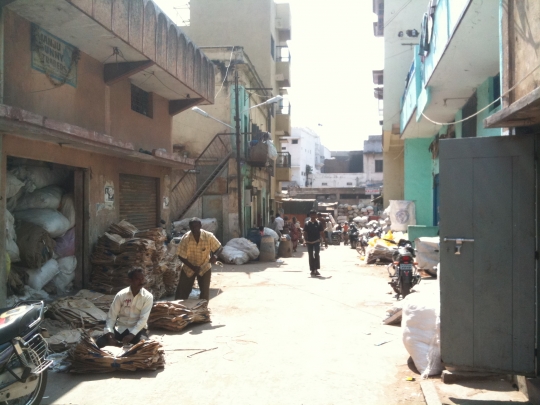
From a visit to Bangalore's City Market, the recycling network's major node.
Another Saturday morning, another Weeknote. This week was not atypically busy, but it sure felt like it – in a good way. Progress was made.
An important theme this month (bye, January) has been reminding everyone around us that Helsinki Design Lab is a mission-driven initiative, rather than just an event. Marco spent a lot of time re-presenting the full scope of the project both in and out of house and it's something that we need to continually push back on since this is a new development.
Helsinki Design Lab 1968 and 2008 were singular events. Like any gathering of great minds, the electricity in the air set other things in motion but those were ancillary benefits and not the core focus. When we started the planning for HDL 2010 we pulled everything back to first principles. What is the mission of Helsinki Design Lab? Only after answering that can you get to a discussion about 2010.
Consider this a rather ungainly beta version:
Governments (and large organizations) are facing tremendous transformation challenges if they are to maintain viability in the future. The challenge today is to develop pathways to systemic & strategic improvements. To do so governments are faced with the monumental task of redesigning both the boundaries of complex problems (healthcare, education, sustainability to name a few) and the ways they deliver. By offering an integrated approach to defining problems and developing solutions, strategic design is an essential capability for governments that aim to meet the challenges of today. Helsinki Design Lab fosters the creation of knowledge, capability, and achievement in strategic design through gatherings, publications, and sponsorship.
In other words, we're helping build design as a strategic competency within government. This is different from recent chatter about design policy in support of the creative industries. That's a good-but-different thing. Strategic design is moving the methods and tools of design upstream where they can have a transformative impact rather than acting as decoration. This is only possible when the designer is legitimately part of early stakeholder conversations: those which are at a strategic level. That's going to require changes to design culture as well as new perceptions about the role of design.
With this as the rough scope of our ambition, you will hopefully agree that HDL is now more of a mission than just an event. From inside, it feels a bit like a startup. We've designed it with three components that each run on different time scales:
- HDL 2010: An event offering a forum to a global community of decision makers and strategic designers, to gain insights from this way of defining challenges and delivering results. This is our legacy and we see it continuing stronger than ever.
- HDL Studios: Within Finland, HDL is developing its own experiments that bring leading strategic designers together with content experts to develop solutions for real world problems currently faced by government. This summer we will run three studios focusing on education, aging, and sustainability. More details on these in the near future.
- HelsinkiDesignLab.org: An online community built for sharing like-minded work happening around the world. When we launch our new site this Spring it will showcase strategic design case studies that take steps towards formalizing knowledge in this area. We hope that the site can become a collecting point for people interested in strategic design.
We've been working so furiously since last Fall that a proper overview of HDL never made it onto this site, but I'm glad it's here now.
And about this week: Wednesday was the highlight for selfish reasons. Between daily schedules and a few people on the floor being out with sickness, the office was unusually empty and still. Marco had scheduled a trip to Oslo on that day but canceled it at the last minute, meaning that no one knew he was in the office and we could concentrate on HDL for a couple solid hours without meetings or other tasks interrupting. We laboriously sketched out HDL 2010 and the Studios on a minute by minute basis so they both feel much more like known quantities now.
On our new floor we have a circular table in the center of the cluster of desks. This is a great place for these longer conversations and it reminds me why I believe in architecture: a slightly more open space and a new furniture plan are already helping our workflow.
The HDL Studios are coming along well with five confirmations from very talented invitees. Unfortunately, this week we also had our first declined invitation – Joanne is too busy as the COO of a new hospital in Singapore to join us for the Aging studio. Understandable.
For HDL 2010 we've been meeting with contractors who will help with the backoffice and other practical details. This is a huge project on its own with a whole new pile of details to look after, but it's exciting because it means we're moving forward.
Seungho is getting up to speed remarkably quickly and spent part of the week chipping in on research for Justin's Sustainability Studio challenge briefing.
Hanna and I have been looking for a storefront space in the center of Helsinki to use as the pop-up office for the HDL Studios that we will run in May and June. We want the studio to feel rooted in the city, and having a physical presence will offer us an additional venue to share what we're up to with a wider audience. Somehow we managed to schedule our scouting trip on Thursday, a particularly snowy and cold day. Nothing like a two hour walk through the snow to start your morning off right.
Yesterday we made an in-principal agreement to bring six top students from one of the local universities into the HDL Studios as research and visualization support staff. This is great since they have very talented students and HDL is sure to be a unique learning experience for them.
My focus this week was on the outward facing bits and core of our the internal machinery. Outside: giving feedback on the new website; press check on the stationary (finally!); and, most importantly, revamping our documents. Inside: transitioning to Basecamp for project management, getting a little to-do happy, and moving the "HDL Brain" spreadsheet from Excel to Google Docs. That's the name of our spreadsheet that tracks budget, schedule of the various components, and our invite list. With the amount of work going into that document I sometimes wonder if it truly will become sentient.
Whew! What a week. I just got back from Abu Dhabi (which brings with it a weather swing of 50 degrees!), where I was a speaker at the World Future Energy Summit, talking about Sitra's Low2No approach to sustainable development. We will post my talk & presentation as soon as it’s available from the WFES website.
It’s been an interesting two days meeting people and connecting thoughts & opportunities. In the context of what is happening here at Masdar, Low2No is an interesting, globally relevant, alternative strategic approach to meeting the sustainability challenge in the built environment. Masdar is undoubtedly a great global experiment creating a carbon neutral city solution from scratch. Low2No addresses the other challenge: how to do it in a legacy-ridden market such as Europe? Not only do we need to better understand what a sustainable city model is but in Helsinki, and Europe generally, we need to understand how to transition from the current legacy system (infrastructure, political, financial, cultural) to a sustainable solution. It’s not only about what that “it” is but, most importantly, how to get there.
Events like the World Future Energy Summit are of interest as they help create a community around strategic issues, bringing many stakeholders together. On a practical level I had some great meetings, many of whom I’ve been connecting with virtually and now they've finally materialized in person.
Yesterday I had a nice chat with Dan Kammen. We shared notes on what we are doing and rekindled our conversation which began a year ago with Low2No. Also met Khaled Awad briefly- was good to finally connect with one of the driving forces behind Masdar. Lastly, but not least, it was a real pleasure to spend some quality time with Peter Sharratt. Trained as an architect, frustrated with the object obsession the profession has developed, now working in the strategic systems/decision making space… he gets it! He is also very insightful about the global opportunities of the Masdar model. Look forward to seeing him in London soon and continuing our partnership around Low2No.
On a more cursory note: my stay in Abu Dhabi was a bit brief, but it's always exciting to be in a new culture/country. There is a real underlying beauty to this place that is challenged by a new physical and cultural layer that has been built in minutes. The challenge here seems to be how to build a future without losing track of the rich heritage and culture that is embedded here. We are talking about finding a balance between the 10 years of new, versus the thousands of years of old.
Aside from the summit, business continues as the usual whirlwind of activities. Had great talk with Darrel Rhea, a friend who is acting as an advisor to HDL, reviewing what we are working on. Hanna was looking at storefront spaces in the city for one of our HDL experiments, Minna was researching catering and cost cuts in the City of Helsinki (interesting combination but they're separate issues), Bryan visited TEM, and with the time difference Justin is working with Adriel and Ezra on the Challenge Briefings at this very moment. We're working on securing our keynote speakers for September as well as a few very busy guests. And…. our team just expanded: we are joined by the talents of Seungho Lee, Masters student at the School of Art and Design (now part of Aalto University). From Korea, to Helsinki, to HDL. Welcome aboard!
This was a big week for us, as it's the first of 2010 that everyone was in one place at the same time. Justin was over from Boston so we took the opportunity to have an all day retreat for HDL. What do you call these all-day-meetings-in-another-place? "Retreat" seems like the absolute wrong word. It's about pushing things forward! I'm reading Michael Barber's Instructions To Deliver at the moment wherein he uses the term "away day." We might steal that term. We also welcomed two more Sitra people to the team on a part time basis and are waiting on some internal figurings-out before we officially welcome two more beyond that. Oh, and we hired our first intern, Seungho, to start next week. All told, that's a 83% increase in team size in a single week!
Marco spent Wednesday in London where he attended approximately 176 meetings in a span of only 6 hours while the city ground to a halt under a light dusting of snow. Apparently those meetings went well because we've now added two more names to the studio rosters. Today we finally secured our 3rd studio lead. This probably seems totally abstract given the lack of details about HDL on this site at the moment, but trust me that it's a big milestone for us.
With this growth come some key questions: how will we share files and data? Sitra has in-house systems but they're not necessarily geared towards the sort of work we need to do, nor the style in which we work. Seems like this is one of the challenges of an 'internal startup:' deciding how much of your parent organization's standard process and tools to adopt and how much do you rethink. I spent a good chunk of Friday researching CRM tools that will let us manage a list of invites without sacrificing experience quality on either the recipient or admin sides. Still undecided but so far I am not convinced by any of the options. For general coordination issues we will probably end up in Basecamp, but I'm still looking for better options.
We spent a good bit of time in front of the calendar moving post-its between little boxes. Things are a little more solid there, but it's a very ambitious time line we have set up. The idea with the home-printed calendar was to just write on it with pencils and plot a new one when it got too messy, but instead post-its are seemingly unavoidable. The next iteration will need bigger boxes that fit more than one post-it (of different colors)!
Justin's taking over primary responsibility for the Challenge Briefings and he'll be working with Adriel and Ezra over the next couple of weeks to get that content into shape. I spent a couple days editing and reorganizing the Briefs so that they're happily three of a kind and ready to enter this final phase of writing and editing. Now that we've been working on this content since last September it's starting to feel like we are developing a new sort of document. It's not an essay, not a manual, not a historical review, not an atlas, not a summary... the Challenge Briefing is somewhere between all of those.
Just got off the phone with Helen to make final plans for her time in Bangalore. She's heading there to spend two months with the Daily Dump, helping them with their work while simultaneously creating a documentary about their recycling efforts. At HDL we've been exploring the idea of an "embedded designer" that brings design muscle into a needed context by embedding themselves within a host organization. While that's not quite the case here since Daily Dump is run by a group of awesome designers, it's still an interesting experience for us as we learn the ins-and-outs of supporting other organizations and working in collaboration with them. Eventually we would like to be sponsoring designers to work within ministries and other governmental silos but we're still working on a reasonable path forward. The hypothesis is that a little bit of design expertise in a completely devoid context can go a long way.
At 11pm on a Saturday the day ends after a quick conversation with Constructing Communication about getting their help on turning the Briefings into beautifully designed documents. But I've Saved the best for last: a quick review of the updated site design from Rumors – lest the excitement of this new file in my inbox keep me from sleeping!
The airport in Austin, TX is filled with droning organ music this morning. It's a little weird. I've stopped here for a two day workshop with XOXCO on my way home from a winter holiday in the US. We spent the days developing a solid plan for the web presence of HDL2010: lots and lots of little things to line up with September only eight months away.
One of the central issues for us is how to capture all of the content related to HDL in a format that is more meaningful than a blog full of posts ordered by reverse chronology. We need to be able to capture the evolution of thinking around a topic and to make that evolution legible. XOXCO has some great ideas so I'm very excited to see what they come up with for us.
Meanwhile, the geniuses at Rumors are cooking on a refined design of the site and we had the chance to review comps for the first time. This thing is becoming real.
Back in the office Marco, Minna, and Justin have begun settling in to our new space while tending to the daily business, preparing for our HDL away day, and giving Low2No some special attention. Joining us for the away day are three colleagues from Sitra who are all joining the HDL team: Elina (media/press), Hanna (project assistance), and Jaana (event management). Welcome!
Drafting up the agenda for that meeting was a Good Thing To Do because it helped discretize some of the larger outstanding issues. We're pretty comfortable with looking after loose ends and handling uncertainty, but some of the items on the docket are more like entire ropes of unsorted issues that appear deceptively simple by virtue of being tightly woven together. Writing an agenda is a good way to force yourself to unravel those ropes, and unraveled they have been.
This week? It snowed; we had a holiday; it was a great. Hope you had a nice holiday as well, now let's get back to work!
I should be sleeping, as I'm on the plane flying to the California for the holidays, but instead I'm writing this weeknote because I'm that dedicated nerdy.
Somehow it seems appropriate that this, our last full week before the holiday, is also the first full week of snow in Helsinki. Goodbye, Winter gloom. The snow really does make daily life more bright and the quality of the light is something special.
We started out with a visit to the comfy office of Demos Helsinki in the city's Viiskulma ("five corners") neighborhood. Having checked out their Peleton project a bit it was nice to hear more of the backstory (English summary here). They started out by looking at all of the decisions that one makes in their lifetime and the potential impact those choices have on your individual carbon footprint. From there, they selected the decisions that have a high footprint potential and asked "who is the gatekeeper for this decision?" The list is counterintuitive and suggests that the people at point-of-purchase have a very important role to play in behavior change. If your builder suggests that you use a certain insulation, for instance, you generally follow their advice. Peleton is about working with these gatekeepers to help them understand the importance of their role.
Demos was a no brainer when I had a call from SIX in London later in the week to talk about social innovation in Finland. They've been commissioned to write up an exciting report on the topic and we were happy to share with them some of the things going on here. We'll post a link when the report is published.
Actually, lots of phone calls and emails this week – mostly Marco's – to catch up with old contacts and start sharing with them the plans for 2010. It's a bit odd to be announcing that here since we haven't really had a chance to give a suitable public overview of where Helsinki Design Lab is headed, but that's only because it has been so fluid. In construction the term "fast track" means that the process of designing and building a building are conducted in parallel, with the early site work and foundations going in before the full set of plans are drawn. This is very much the approach we've had to HDL. With the foundations just about in we're also nearing completion on the design, so to speak, and I'm making it my goal to update this site in the first week of January with a clearer plan for 2010. Bear with us.
Some logistical things: we packed up the office so we can move to a new floor in the new year; Marco visited TAIK to talk about having some of their students work with us in the Spring; Martin and I made a final decision on the paper stock for our stationery (Munken Lynx, if you're curious) and finalized the design; and I had a late night check-in call with XOXCO. Those time zones are killer.
Thursday we met with Pekka T. to talk about possible venues and agreed to go with him on a visit to City Hall in early January. This is an important one for us: we definitely do not want to host HDL in a typical congress hall or something overly formal like Finlandia, beautiful though it may be. HDL 1968 was held on the grassy fields and in the crenelated environs of Suomenlinna. In 2008 we temporarily converted a warehouse space in Katajannokka into an amenable environ for conversation. This year, as we begin to hone the focus of HDL as an environment for enhancing design as a strategic asset for government we hope to host the event literally within the halls of government – to embed design there, if even temporarily for now. We're also trying to avoid the all-in-one sort of venue that traps participants in a single place, regardless of how comfortable it may be. If things work out, we'll be hosting HDL across a couple different locations around Senaatintori. This is a big if, but an exciting one.
And I've saved the best item for last: we asked Adriel and Ezra to have 80% drafts of their respective challenge briefs done for us this week and they took that quite literally, sending the files at the end of the day Friday! I'll be pouring over the briefs during the flight, but first I think I'll sign off and enjoy this sunrise over the Baltic.
We've been digging into the case study content. Justin and I have been working on drafting up case studies of the various projects we visited in November. Thankfully there were two of us because it's very helpful to have two sets of notes so as to provide a complete picture of visits and interviews. Also, this must be journalism 101, but it really does make a big difference to review and transcribe notes as soon as possible after an interview. Next time we do a round of case study visits we will definitely build in more time for processing and documentation.
Minna and I had the great pleasure of visiting Jaakko Ihamuotila and Yrjö Sotamaa in their respective homes to interview them on video about their roles as organizers of the 1968 event, which was HDL's predecessor. Both of them mentioned the Cop15 proceedings in Copenhagen to illustrate how it has taken us 40 years to come back to a discussion that was quite active in the late 60s and early 70s.
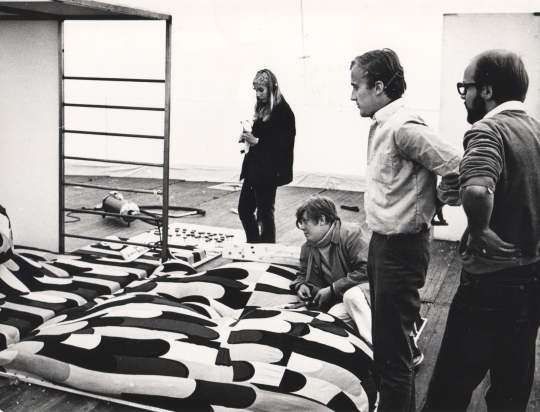
Contemplating an environment for Mentally Handicapped Children at HDL 1968. Photo by Kristian Runeberg.
I was also encouraged to hear both Jaakko and Yrjö mention the important role played by two design exercises held at HDL 1968. Participants were asked to collaborate on the design and prototyping of two items which offered an opportunity for ideas to be applied toward practical needs. I'm hoping that there was not an intended connection between the two projects – a mobile reindeer slaughter facility and an educational environment for mentally handicapped children – but those specific choices are a mystery that we'll chalk up to the magic decade that was the 1960s.
The more we introduce new people to HDL the more we refine the sequence of documents that progressively explain the project. I've organized a folder on the server with versions of our project explanation in two sentence, one page, and five page versions. These are critical to have on hand at a moment's notice and we continually refine them as the necessary focus shifts and details become more concrete. This week we put these documents to work in meetings with the Ministry of Education, Foreign Ministry, and Aalto University who will all be contributing to HDL 2010 in varying ways. Lots more of these sorts of meetings in the coming month or two.
We confirmed one of the participants in our Sustainability studio. This is an important focus for us leading up to the holiday.
Speaking of which, we took a long lunch on Tuesday for our team Joululounas ("Christmas Lunch") which reminds me that next week is the last before the holiday. There's a lot to do before we close out the year but it's feeling manageable.
Besides, we seem to work better under pressure anyways.
Is it really december already?
This week we learned the true cost of a long trip. It takes at least a week to catch up on everything that you put off because you were on the road. The accumulation of missed emails, the necessity of thank yous and greetings to everyone you met on your travels, the processing of a huge pile of receipts (47 expense reports!) ... this adds up to another week that disappears from the calendar.
Adriel and Ezra are in full swing on their challenge brief documents. Looks like we were ever-so-slightly ambitious in our original mid-December timeline, but they're still going gangbusters and are developing some great material. Like any research or fact-finding process, we're coming to realize that it will be important to have a resting period where we can collectively let the material soak in before going in for another round of edits and revisions. So we'll get the briefs to draft by mid december and then pick them up again in the middle of January after we've had a chance to get some more eyes on the content.
Off in Barcelona, TwoPoints is nearing completion on the design of the Helsinki Design Lab visual identity system. We've sent out some draft material to the printer for a quote on papers and envelopes and all those necessities of business. Meanwhile we've started working with the templates internally to format our documents in a coherent manner. Some kinks still, but one last round of revisions is ironing those out nicely. It's weird to see this thing that has been such a homegrown project start to grow up a little. The first time I printed off our one page description of HDL with the official template was a nice moment in the office. It's a simple milestone.
Work on the website is underway as well. We signed off on the spec from XOXCO which means they'll be in wireframes and schemas soon. We owe them a draft of the HDL case study format which I have been woefully behind on completing. Sorry guys!
Even though it's strange to work on the weekend in Finland, yesterday we were on the phone with Helen, a talented and adventurous designer/filmmaker based in the US. She'll be off to Bangalore in February to spend a few months with Poonam Bir Kasturi and the Daily Dump team helping them tell the story of their work through a documentary film. It's a twofold job we've asked Helen to do: make a film but also spend a couple months working with the Daily Dump as a team member. Construction and reflection. HDL is a big fan of the work that the Daily Dump is up to and we're excited to be able to support them.
Speaking of which, this week Marco has been starting a few conversations with people who may be able to help us support more projects in the future. Not much to say about this at the moment, only that it's something we would like to be able to do.
We dipped into architecture and did a tiny bit of work on our physical space as well. Just as we approved the design for a renovation to our little corner of the Sitra offices we've been relocated to another floor. Friday was spent furiously sketching out some new layouts in order to get the furniture order out before the holiday. Priority #1: vast whiteboards.
And one final but important note that I forgot from last week's update. While I was away Minna and Marco visited Juhani Pallasmaa at his home to interview him on tape. Juhani was one of the initiators of the predecessor event to Helsinki Design Lab (we're calling it HDL 1968) and his interview is one in a series that we're doing with the original crew. It's fascinating material and we'll post bits of it here once this video project is wrapped up.
Lots of moving parts around here; doing our best to keep them all organized and operational.
If you like reading these updates about what's happening at Helsinki Design Lab, you may care to know that there are a growing collection of offices around the planet who are posting similar updates. Check out Weeknotes.com for more.
